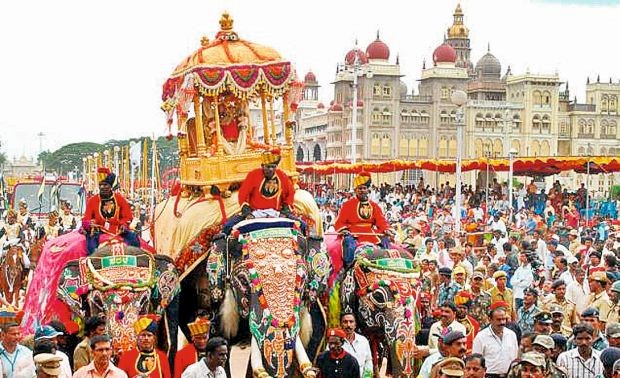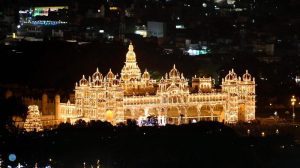
Quick guide to Mysore Dussehra fest; the legacy and what not to miss

If Kolkata celebrates Goddess Kali in all her glory during Dussehra, Mysore pays homage to Goddess Chamundeswari, who had felled a menacing buffalo-headed Mahishasur, terrorising the region. But, no Ravana effigies are burnt here, instead this world-famous 10-day festival, is a glorious blend of divine worship and display of royal splendours, which includes a golden throne, with a bunch of activities around the local culture thrown in.
In fact, 290 cultural events play out over the 10 days across eight venues in Mysuru.
This festival, took off on Monday (September 26) with President Droupadi Murmu inaugurating the carnivalesque event by paying obeisance to a flower-bedecked idol of goddess Chamundeswari.
Officially designated as a state festival (Naada Habba), the festivities will end with a spectacular procession or the Jamboo Savari of caparisoned elephants carrying the Chamundeshwari idol safely ensconced inside a golden howdah on October 5 followed by a torchlight parade.
Also read: Mysore pak, masala dosa part of breakfast menu for PM at royal palace
Slice of history: A legacy of the Vijaynagara emperors
This massive festival is a legacy of the Vijayanagar emperors who had ruled between the 14th and 17th centuries. There are records of travellers like the Italian Nicolo Dei Conti having witnessed the celebrations in 1420 and penning a detailed account. There are references to the “great feast that takes place for 9 days” during September in the writings of Domingo Paes (1520-22), who is said to have visited the kingdom in the early 16th century AD. He also spoke about the contemporary ruler of the “kingdom of Bisnaga” (for Vijayanagar)
Abdur Razzak of Persia, who visited Vijayanagar between 1442 and 1443; and Fernao Nuniz (1535-37) from Portugal, have talked about the celebrations at the Palace with complete description of wrestling, sacrifices, dancing girls and singers occupying the stage.
One account narrated how the nobles entered with horses, elephants, saluted the king and after they were seated, the wrestling match would commence.
Later, the Wodeyar rulers made Chamunda their tutelary deity, and Raja Wadiyar who ascended the throne in 1610 CE at Srirangapatana started the Navaratri celebrations on a grand scale.
It was however during the time of Nalwadi Krishnaraja Wadiyar who ruled from 1902 to 1940 that the grandeur of Mysuru Dasara reached its apogee and this grandeur has been documented in the murals of the Amba Vilas Palace. The tradition of the regal Jambu Savari kicked off in 1805 during the reign of Krishnaraja Wodeyar III.
 Most important venue in Mysore Dussehra
Most important venue in Mysore Dussehra
The most important venue in this festival is in the grounds of the 20th-century Mysore Palace. This transforms into an open-air setting with the majestically lit palace providing a stunning back-drop to classical Indian performances. Every evening, as the sun sets, nearly one lakh palace lights are switched on all at once creating an awe-inspiring sight. Visitors have to weave their way to this spot.
A key attraction
Mysuru Dasara Flower Show being held at Kuppanna Park is one of the major attractions of the fest. An exquisite collection of flowering plants is showcased during this event, offering visitors a visual treat.
Also read: Hampi: The enduring appeal of world’s largest city in 16th century
A line-up of interesting events
Wrestling events, a Puneeth film festival, rangoli exhibition, an industrial expo by women entrepreneurs, a heritage cycle ride from Townhall, farmers activities, a milking competition, a yoga event etc., have been lined up during the event.
Off-the beaten track
Visitors can also try a tonga ride, a morning walk at Kukkarahalli lake and for lovers of literature, a visit to RK Narayan’s museum may just turn out to be the icing on the cake. His red-oxide floored home converted into a museum by the Mysuru City Corporation in 2016, houses his achievements and awards, like the Padma Bhushan and Padma Vibhushan which are on display in glass cases, his clothes and books.
There are also articles written by Khushwant Singh, a great admirer of the writer, about Narayan’s “deceptive” humility. Check it out for more memorabilia on one of India’s most finest writers.
Jambu Savari- Gajapayana
This is the most essential and not-to-be missed event of the festival. The Jambu Savari starts with a solemn puja held in a temple within the palace complex, (this savari kicks off from the palace), after which the procession is inaugurated by the governor and the scion of the Wodeyar royals. After which, they climb a stage and shower flowers on the idol of Chamundeshwari, sitting in a golden howdah on top of an elephant called Abhimanyu.
Clothed in the most brilliant blues, yellows and magentas, the elephant will lead the procession. Amidst sounds of cannon fire, he will be accompanied by several other colourfully attired pachyderms and dance groups, music bands, horses, camels, vintage cars.
This colourful tableaux will pour out from the palace gates on to Mysore’s streets. The grand pageant usually moves at a snail’s pace and takes about three hours to cover the 4.5km-stretch to the Banni Mantap grounds. The entire route of the pageant is cordoned off with ropes and crowds throng either side of the road to cheer them on.
The tiny idol of the goddess gets the loudest cheers and the most attention, as the young scamper after her and the elderly pay their respects by bowing before her. After all, she is the fulcrum on which the entire fun fiesta revolves.


